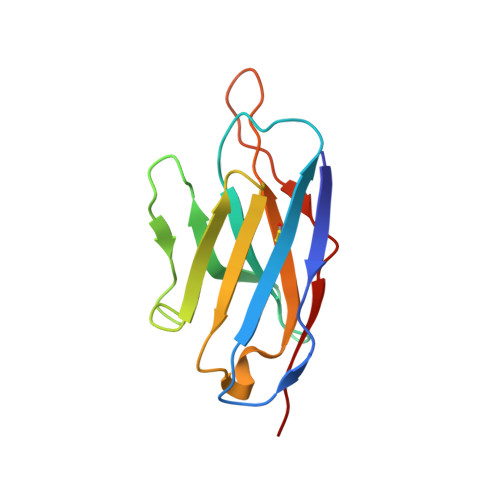A broad neutralizing nanobody against SARS-CoV-2 engineered from an approved drug.
Liu, Q., Lu, Y., Cai, C., Huang, Y., Zhou, L., Guan, Y., Fu, S., Lin, Y., Yan, H., Zhang, Z., Li, X., Yang, X., Yang, H., Guo, H., Lan, K., Chen, Y., Hou, S.C., Xiong, Y.(2024) Cell Death Dis 15: 458-458
- PubMed: 38937437
- DOI: https://doi.org/10.1038/s41419-024-06802-7
- Primary Citation of Related Structures:
8XK2, 8XKI - PubMed Abstract:
SARS-CoV-2 infection is initiated by Spike glycoprotein binding to the human angiotensin-converting enzyme 2 (ACE2) receptor via its receptor binding domain. Blocking this interaction has been proven to be an effective approach to inhibit virus infection. Here we report the discovery of a neutralizing nanobody named VHH60, which was directly produced from an engineering nanobody library based on a commercialized nanobody within a very short period. VHH60 competes with human ACE2 to bind the receptor binding domain of the Spike protein at S 351 , S 470-471 and S 493-494 as determined by structural analysis, with an affinity of 2.56 nM. It inhibits infections of both ancestral SARS-CoV-2 strain and pseudotyped viruses harboring SARS-CoV-2 wildtype, key mutations or variants at the nanomolar level. Furthermore, VHH60 suppressed SARS-CoV-2 infection and propagation 50-fold better and protected mice from death for twice as long as the control group after SARS-CoV-2 nasal infections in vivo. Therefore, VHH60 is not only a powerful nanobody with a promising profile for disease control but also provides evidence for a highly effective and rapid approach to generating therapeutic nanobodies.
Organizational Affiliation:
State Key Laboratory of Virology, Department of Thoracic Surgery, Renmin Hospital of Wuhan University, Wuhan, 430060, China.

















